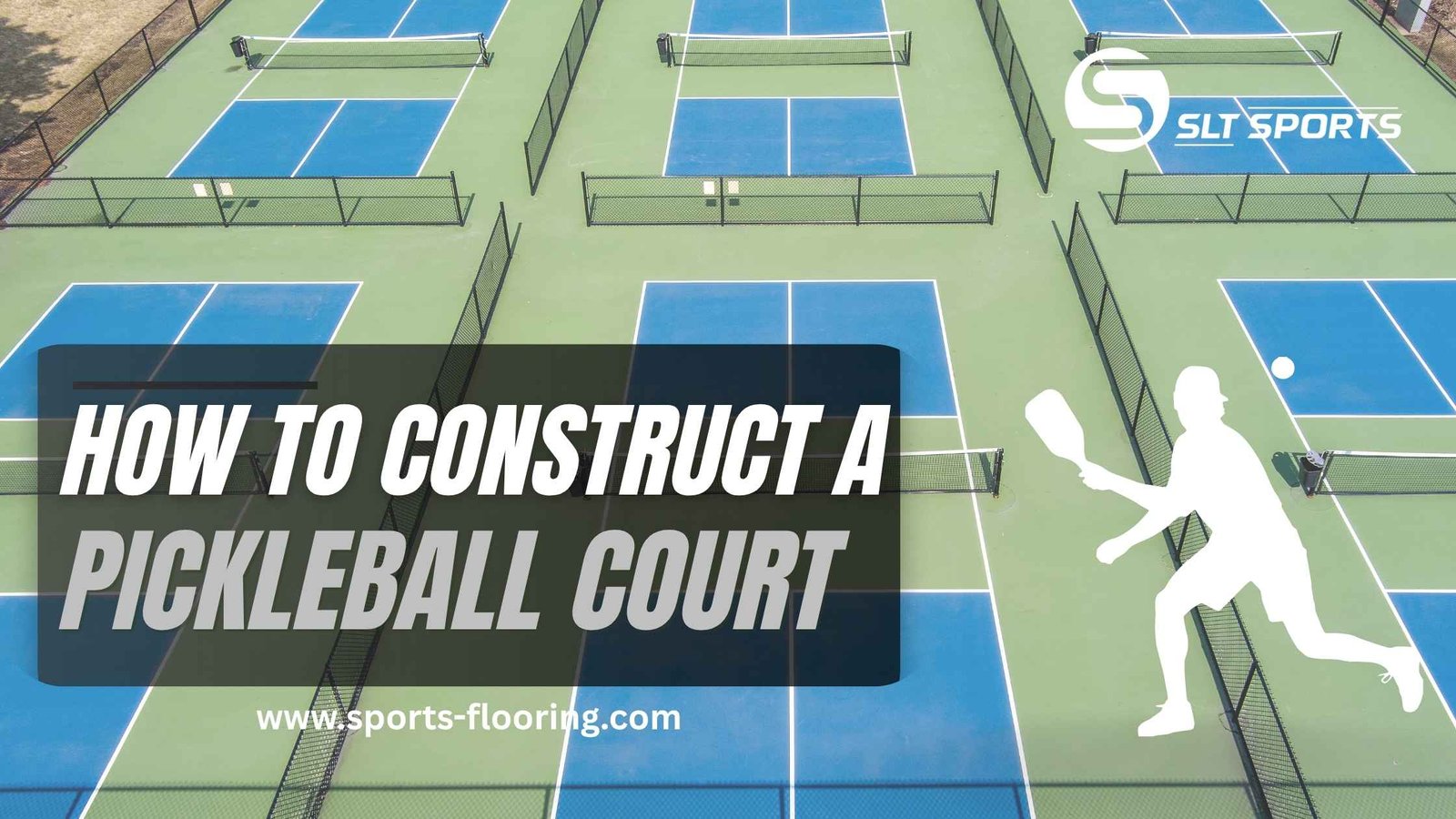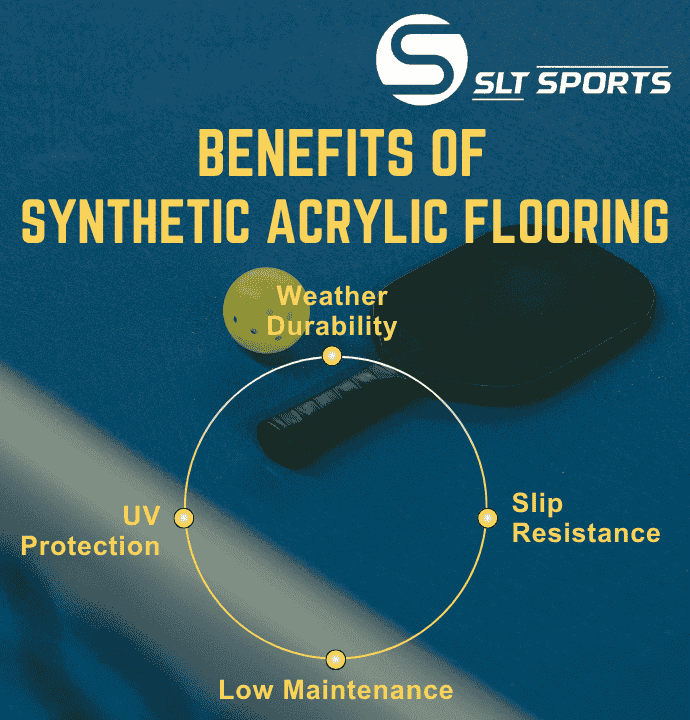
Pickleball is fast becoming one of the most popular sports in India, with players of all ages playing across housing communities, schools and sports clubs. With its compact layout, fast rallies and easy rules, it’s an exciting game to play. But behind every great game is a well built court and at the center of that is the right pickleball court construction with the quality of right pickleball court flooring.
Professional pickleball court construction is more than just laying a surface and setting up a net. From selecting the right pickleball court size to choosing durable, slip resistant materials like synthetic acrylic flooring, every decision impacts playability, safety and longevity. A strong foundation, proper surface coatings, accurate zoning and weather resistance are all critical to performance.
The ideal court starts with a stable concrete or asphalt base, followed by a multi layered synthetic system that includes resurfacers, cushion coats (if needed) and UV resistant color finishes. Accurate line marking completes the playing surface to international standards.
This blog will walk you through every step of building a court that delivers professional performance in Indian conditions. Whether you are building a residential court or a commercial facility, understanding the pickleball court construction process is key to creating a surface that lasts.
Importance Of The Right Pickleball Flooring
The choice of pickleball flooring is at the heart of the game’s performance, safety and long term durability. A well built surface ensures proper ball bounce, shock absorption and slip resistance for the players. Flooring that is uneven or poorly coated can lead to injuries, gameplay disruptions and early surface damage. That’s why professional flooring is not just a luxury but a necessity for anyone serious about building a pickleball court.
In India’s diverse climate, synthetic solutions like acrylic flooring offer many advantages. They are UV resistant, all weather compatible and customizable in terms of grip, color and cushioning. Whether it’s for professional play or recreational use, the floor must support fast footwork and maintain consistency throughout the year.
Pickleball Court Size And Layout Standards
A pickleball court dimension is 20 feet wide and 44 feet long and is used for both singles and doubles matches. Around this court a minimum playing area of 30 feet x 60 feet is recommended and for competitive level installations 34 feet x 64 feet is ideal.
This layout includes:
A non-volley zone, also known as the kitchen, extends 7 feet from the net on each side.The remaining area is split into two service boxes, 15 feet deep and 10 feet wide.
Line marking is critical for fair play. Any variation in size or angle can lead to disqualified tournament courts and uneven play.
Where To Build Your Pickleball Court
Site selection is key. An ideal location for a pickleball court must be level, stable and no drainage issues. Whether in a backyard, rooftop, school or sports complex, the ground must support the weight of the materials and players.
Environmental factors matter too. For outdoor courts, orient the court north–south to minimize sun glare. Also, avoid placing courts near tall trees, waterlogging areas or areas with heavy winds unless fencing or barriers are planned. A flat site reduces excavation and speeds up the build time.
Flat site reduces excavation and saves time. Proper site selection is the foundation for efficient and long lasting pickleball court construction especially in areas with heavy rainfall or temperature fluctuations.
Sub-Base: Concrete Or Asphalt
Your court’s longevity and performance starts at the sub-base. The most common materials used are concrete and asphalt. Each has its own advantages but both must be laid correctly for a uniform and stable surface.
- Concrete Base: Durable and low maintenance. Ideal for long term installations but requires expansion joints and proper curing.
- Asphalt Base: More cost effective and quicker to install. But may need to be resurfaced more often depending on wear.
Regardless of the material, a 1% slope is required to allow for water drainage. A poorly constructed sub-base will result in surface cracks, puddles and premature surface failure.
Applying The Synthetic Acrylic Flooring System
Once the base is ready, it’s time to apply your synthetic acrylic flooring. This multi-layer process creates a smooth, colorful and high performance surface. These coatings are liquid based, UV resistant and designed for sports use.
The steps are:
- Concrete Primer: Enhances bonding between concrete and coatings.
- Acrylic Resurfacer: Fills in minor imperfections and creates a consistent texture.
- Cushion Layer: Adds shock absorption for player comfort and reduced injury risk.
- Acrylic Color Coating: Final layer that provides vibrant color, slip resistance and durability.
The result is a surface that performs in all weather conditions and looks great with minimal maintenance.
Synthetic Acrylic Flooring Benefits

For outdoor sports courts in India, synthetic acrylic flooring is the way to go. It offers the perfect blend of grip, comfort and weather resistance. Unlike tiles or grass, it doesn’t warp, crack or require excessive maintenance.
Key benefits:
- Weather Durability: Performs well in heat, rain and humidity.
- Slip Resistance: Reduces chances of falls during fast lateral movements.
- UV Protection: Retains color vibrancy over time even under harsh sun.
- Low Maintenance: Requires minimal cleaning and resurfacing.
These are the reasons why it’s the preferred choice for builders, institutions and sports facility developers.
Line Markings: Accuracy Matters
Line marking is critical for regulation compliant courts. The lines define the gameplay area and must be painted with precision using court marking paint. Standard line width is 2 inches and the colours must contrast strongly with the court base colour for visibility.
Acrylic based paints are preferred for durability and weather resistance. Always allow the surface to cure fully before marking and use masking tape to prevent colour bleed. Incorrect lines can change the gameplay so best done by experienced sports flooring contractors.
Drainage For Outdoor Durability
Even the best surface will deteriorate if water accumulates. A good drainage system ensures water doesn’t pool on the surface and increases the court’s lifespan.
Drainage features to consider:
- Sloped Surface: At least 1% gradient for natural runoff.
- Perimeter Drains: Direct water away from the court.
- Grating and Gutters: Especially useful for rooftop or high density urban locations. Drainage must be integrated during the base construction and tested before applying top coats.
Lighting And Fencing
To make your court usable 24/7 and safe for recreational play you’ll need proper lighting and fencing. These will allow play to continue after sunset and keep the court secure from external disturbances.
- Lighting: Pole mounted LED lights at corners or midpoints. Light poles should be at least 14–16 feet high to avoid glare.
- Fencing: Chain link fences, 10–12 feet high, to keep the ball in play and define the court boundaries. Good lighting and fencing is essential if your court is part of a commercial or community facility.
Pickleball Court Surface Colors And Aesthetics
Colour plays a functional and aesthetic role in court design. A well chosen colour scheme improves visibility, defines court zones and enhances overall appeal.
Popular combinations:
- Blue inner court + Green outer court
- Grey with red boundary zones
- Custom branding colours for clubs or institutions
The acrylic topcoat is available in standard and custom colours. Choose colours that are fade resistant and provide visual contrast for line markings. Court aesthetics can impact player satisfaction and also boost social media presence for clubs and academies.
Pickleball Court Maintenance Tips
While synthetic acrylic courts are low maintenance, a regular maintenance routine will ensure optimal performance and life.
Maintenance Guide:
- Weekly Maintenance: Sweep away dust, leaves and debris with a soft broom or blower.
- Monthly Maintenance : Wash with water and mild detergent to remove surface buildup.
- Annual Maintenance: Check for wear, cracks or fading.
- Re Apply Coat every 3–5 years: Apply new topcoat depending on usage. Never use harsh chemicals or metal brushes as they will damage the top layers.
Working with A Professional Pickleball Court Material Supplier
For best results, you need to source materials from a reputed pickleball court flooring supplier. While installation is done by certified contractors or local applicators, the performance of your flooring system depends on the quality of materials used.
Look for suppliers who offer:
- High-performance synthetic acrylic flooring systems
- Technical product support and usage guidance
- Surface coating recommendations for Indian climate
- Connections to trained applicators or certified partners
- Material warranty and long-term durability assurance
SLT Sports is one of the leading manufacturers of synthetic acrylic sports flooring systems in India. They provide top quality products like acrylic resurfacers, cushion coats, color coats and line marking paints — all meeting international sports standards. They don’t install the courts themselves but can guide your applicator on how to use the products for best results during pickleball court construction.
Conclusion:
Building a pickleball court is not just a one-time job — it’s an investment in playability, safety and long-term usage. By choosing the right pickleball court flooring, understanding pickleball court size and applying synthetic acrylic flooring the right way, you create a space where games are won, communities grow and players thrive.
Whether you are building a rooftop court in Delhi, a school court in Bangalore or a club facility in Mumbai, follow these professional standards and your court will last long. With high performance materials from SLT Sports, one of the most trusted synthetic acrylic flooring suppliers in India, you can build a court that looks good and performs like a pro year after year. For anyone planning pickleball court construction, using the right materials and design approach makes all the difference.
Frequently Asked Question
Synthetic acrylic flooring is the best option as it’s weather resistant, slip resistant and long lasting especially in Indian climate.
Sweep weekly, wash monthly and recoat every 3-5 years. Don’t use harsh chemicals or abrasive tools.
SLT Sports is one of the leading synthetic acrylic flooring suppliers in India, providing resurfacers, cushion coats, color coats and line marking products that meet international standards.
Yes. While the material can be sourced from manufacturers like SLT Sports, installation should be done by certified contractors or trained applicators to ensure durability and performance.
Yes, pickleball courts are good for backyards and rooftops. Just ensure the surface is flat, well drained and structurally sound to handle player weight and flooring material.

